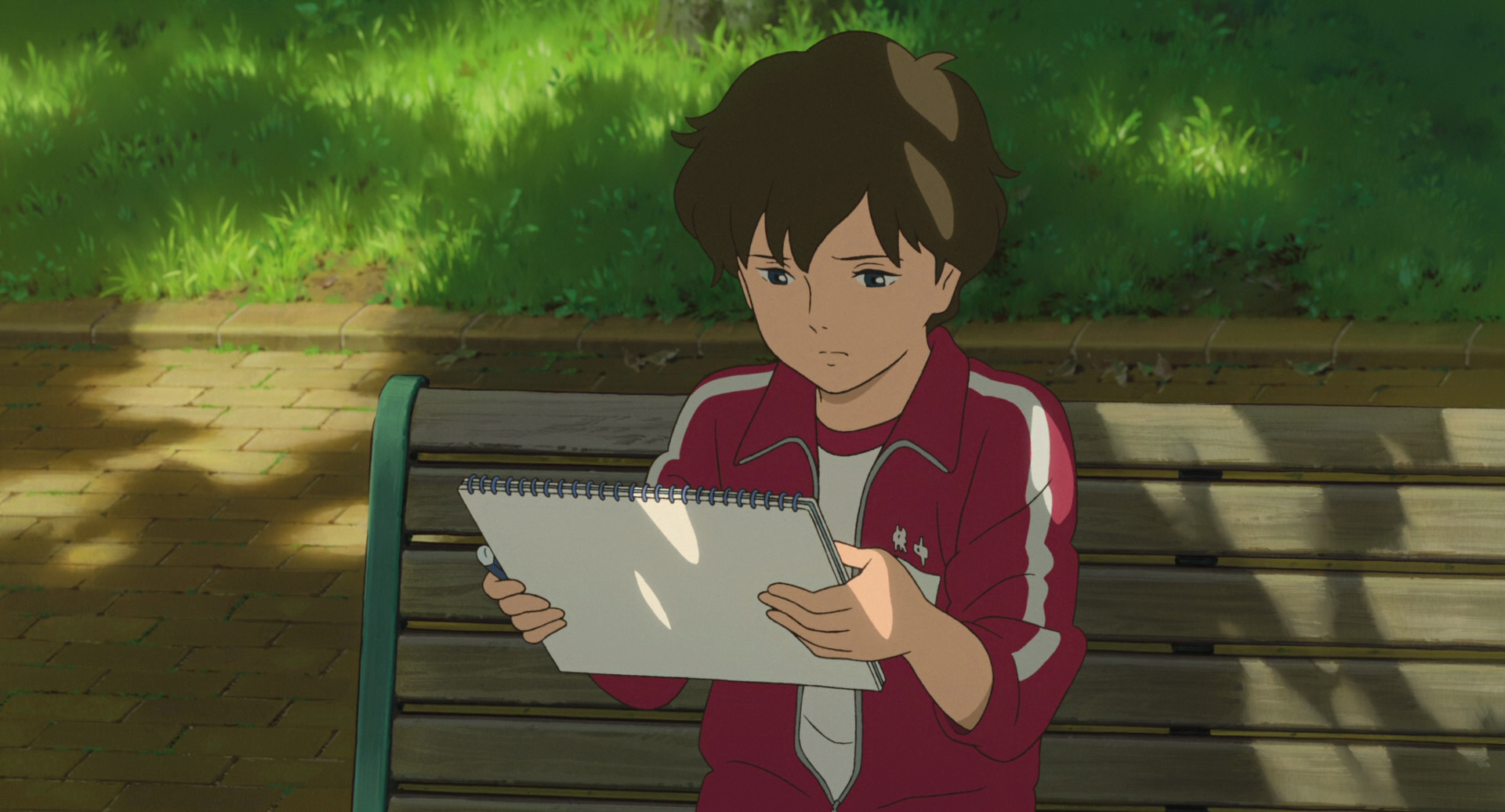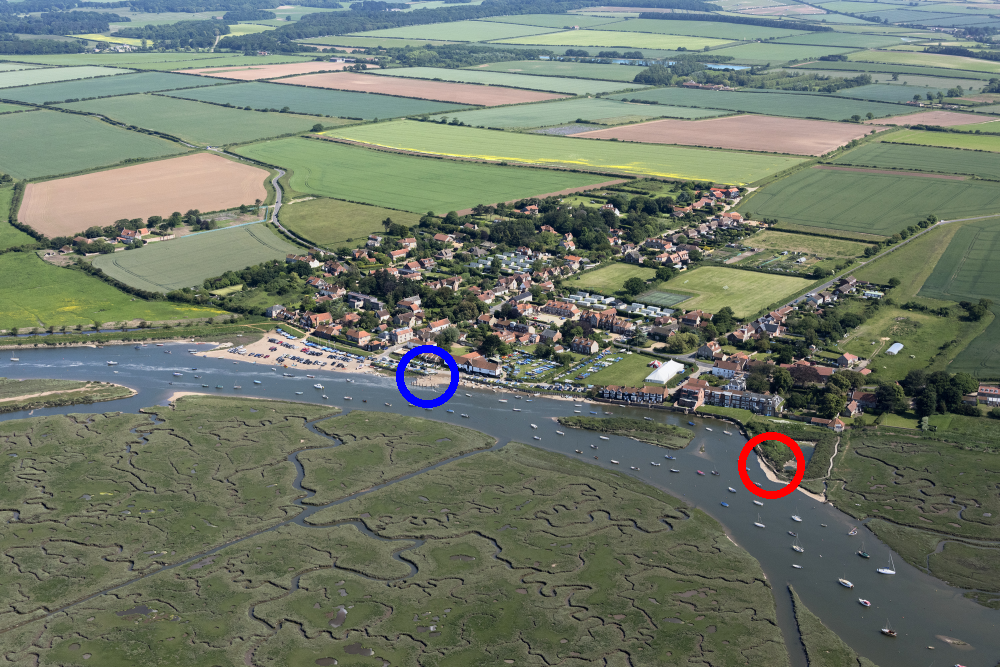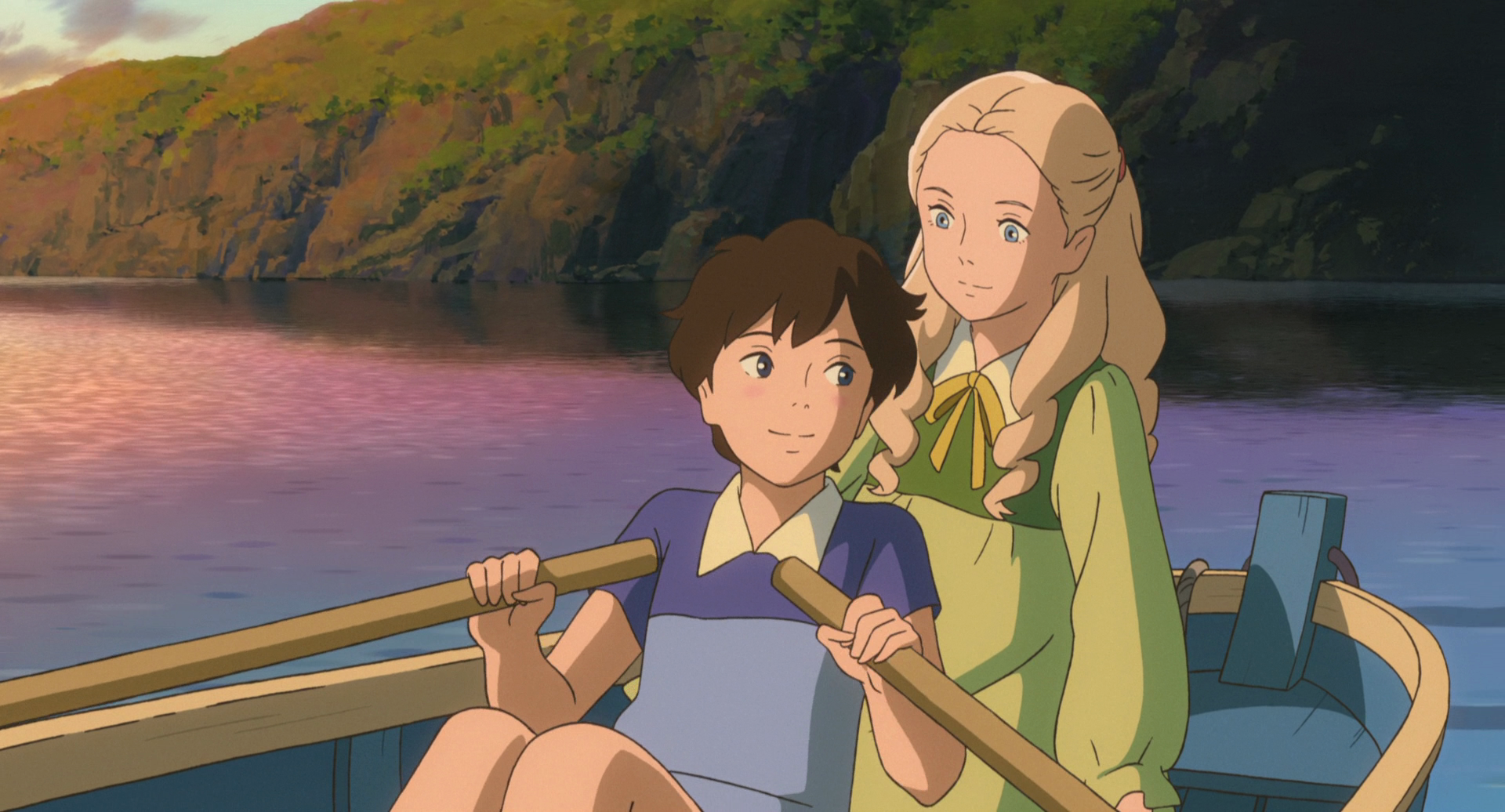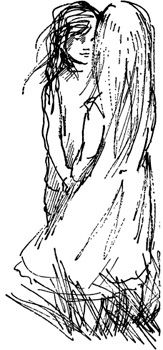When Marnie Was There: book and movie
In a nutshell
be me
> want to determine how gay Anna and Marnie were made to be after watching When Marnie Was There
> read the novel, it was written in the 60s so should be tepid
> discover the novel is even gayer
Quick background information about the book
When Marnie Was There (1967) is a magical-realist book by British
author Joan G Robinson (1910-1988). It is a novel. Though it's only 267/288
pages long, so I'd call that a novella, or maybe a light novel, to make its
fate as an anime sound natural. My county library calls it juvenile fiction
…
which sounds pejorative to say the least, as if to shame me for reserving it.
Perhaps it's catalogued like that cuz of how noddyish Robinson's other books
are, with titles such as Teddy
Robinson (1953).
While by far Marnie is Robinson's magnum opus, it somehow never made it into the canon of British children's literature. None of her books did. Her last publication was in 1978. Marnie seems to be moderately popular in Japan, but cannot determine to what extent exactly; dunno its reprint history there. Judge a book by its cover; here is an assortment of reprints:




Basic differences
A user-submitted article for My Anime List represents the most earnest English-language effort I found in comparing the book to the movie. It’s a very lovely read, it really is; it compares / contrasts the most high-level aspects. It first touches on the difference of setting.
The book was set in a seaside town of Norfolk, England but was changed to a similar setting in Japan so names apart from Anna and Marnie were changed as well. You surely won’t read anything about a Tanabata festival in the book. Also, the dark and dreaded wind mill is a silo in the movie. mal
In the movie, the fat pig
incident is set at the local Tanabata
festival. In the book, it is set at the Post Office; a visit to Miss Manders to
collect jars to pickle samphire, as it’s quaintly put. The circumstances are
similar: both involve Anna being dispatched there as a chore, that results in a
spat with a local girl and her group of friends.

sanfereven is. Grows on marshes.
It is a windmill in the book cause that's normal of the pancake flat landscape of Norfolk. It isn't normal in Hokkaido.
Anna’s introversion in the movie [is] so much more depicted in the book to the point that some readers might say she’s frustratingly unlikable.mal
Studio Ghibli did her a favor by giving her sketching as a hobby.mal
Kinda mean desu. It's more down to the narrative qualities of a book. Anna indeed, does not sketch in the book, and by some measure that makes her boring. I wasn't bothered though; in the movie Anna's sketching hobby is only important for one scene: the opening scene with Anna sketching in the playground where a teacher very nearly takes interest in her her hobby, only to be casually distracted by something else; she nearly opens up a vulnerable side to her, only for that to be glibly dismissed. Panic attack ensues.
Only a few words are exchanged in that scene, but it's very powerful. As any visual medium is meant to do, it's show-not-say. Anna's sketching is not really brought up after that, other than to connect some scenes together. The counterpart to that scene in the book is pages upon pages of brooding, of internal monologue. They're equivalent, I personally don't think the latter is necessarily weaker.

how the mystery was solved that was a bit different. In the book, Anna met Sayaka’s entire family after realizing that meeting Marnie had not been real.mal
After suspecting Marnie had not been real, that is.
She became friends with the entire household and together they investigated about the girl behind the diary that was left behind in the house.mal
This indeed represents the most major structural difference between the book and movie. Anna meeting Priscilla/Sayaka, learning about the diary, the truth about Marnie, etc, is an entirely dedicated and in-depth arc in the book. Entirely separated by the equivalently dedicated and in-depth arc of Anna's encounters with Marnie, up to her final major encounter with her with the apology scene.
Scenes from each of these arcs are interleaved in the movie however; Anna gets to know Sayaka/Priscilla before she goes on the silo/windmill excursion with with Marnie, for example. Resolving the reality of Marnie is an on-going challenge in the movie, rather than separate act.
Both the book and the movie did not discuss exactly how Anna met Marnie and whether it was all just an imagination or a dream.mal
Here's the cincher. The book unfortunately does not clarify the ontological status of Marnie. Most theories about the movie continue to apply to the book. Is she a delusion? A ghost? A spiritual projection? Time travel? Dream? Could talk about this forever…
Geographical differences
[The following is an except of a convo I had while reading the book]
I'm doing sheer amounts of mental gymnastics trying to picture the geography of the marshes described in the book without the bias of how the geography was described in the movie. Notwithstanding the actual textual description of the area it gives on the opposite page, this is how it is illustrated in the book vs the movie.


[Response] i mean you still wouldnt be far off if you just straight up assumed that it was the same as the movie
Book describes it as a dockyard of houses that supposedly(?) looks out onto a marshland. It also describes a creek, I have no idea where such a creek would be positioned. It also describes the Marsh House when she looks—not ahead—but to the left.
I basically spent ten minutes rereading one page trying to figure out how everything is meant to be in this Marnie universe.
[I figured it out in the end]
I finally got to the bottom of how the setting of When Marnie Was There the book is laid out, by referring to the actual real life location it is based on. This pictures is the marsh in low tide. In blue is Anna's side of the marsh, and in red is where the Marsh House where Marnie appears. If you're familiar with the movie, or indeed scroll up and see the screencap I sent, you would know that the movie depicts the Marsh House as being across the marsh, with the opening to the ocean to the left. The book has the Marsh to the left, and the ocean ahead.

Now some of you might be rolling your eyes and think yeah, yeah, but don't
try and cross-reference the movie and book, there's no point (etc)
but
actually, the marsh house being orthogonal in the movie rather than parallel
wasn't even strictly my source of confusion. The book itself was just
inherently confusing, to me at least cause I guess I'm a dumdum who doesn't
know geography words: I was tripped over by the description of the creek, so I
was like wait, so it isn't a marsh? It's just creek? Or is it a creek that
opens into a marsh? Or is a creek and marsh the same thing?
and doubly
confused when it described the creek in relation to the Marsh House, being on
the bend
. It did not occur to me that the creek was inset to the marsh.
So that explains everything, I'm just dumb.
Tragedy, and narrative styles
A difference between When Marnie Was There the novel vs the movie. The circumstances surrounding when Anna and Marnie venture into the silo/windmill is far more tragic in the book than in the movie.
One of the things I can see the movie not having enough time to adapt or possibly couldn't have adapted satisfyingly: In the novel, while Anna dearly loves Marnie, she begins to increasingly sulk silently about how Marnie has a wonderful family and how she spends time with her other friend Edward/Kazuhiko. This is faintly…present in the movie, with Anna's jealousy of how Marnie spends time with Kazuhiko, but this is much more viscerally present in the book where I, the reader, am directly plugged into Anna's internal monologue.
She gets upset about things like how Marnie built sandcastles with him, spend days with him after not spending days with her… it made me sad because I really identified with this experience, being irrationally needy and distressed when I don't feel like a good enough friend.
Because of these circumstances, all of this reaches an especially tragic climax when Marnie abandons Anna at the windmill/silo. The last straw. The windmill in the book was also quite a bit more scary and made more sense why it would be scary; Anna and Marnie find ladders are easy to climb but difficult to get down, and are not being able to even feel for the ladder in the darkness, etc. It plays out like drowning in the ocean while trapped in a shipping container, or being buried alive.
The significance of the scene as adapted in the movie wasn't quite as hard hitting, basically. But again, it might just be a quality of the written word that can't be reproduced in another medium. Books have all this time to examine a characters internal monologue, and psychoanalyse everything.
[Response] From what i remember of howls at first it was similar but due plot points the book goes in a completely different direction including with characterization. So i think for narrative they spliced some elements. I wouldn't say westernize it but shifted things to be more friendly and have an outcome on a more positive note. Both movies I think are more setup with a personal growth story for that heroine. The books seem like they due as well but not in the same way.
besides the movie has that family vibe thing going for it. by doing the route of future husband leading to anna it helps complete that narrative. I suspected the book was different in regards to reveal and probably not even related by blood. i'm curious to know however so feel free to spoil that to me at least.
The narrative completes in the book the same way: Marnie is Anna's grandmother, although the reveal is a little more slow and takes places over the few last chapters, unlike the movie where it kind just happens in a conversation. Now, you know I said that the book turned out to be more gay than the movie? It's also turned out that the book is more incestuous than the movie. Because if you note what I said earlier about Marnie and her cousin: she marries her cousin.
BBFC rating: /u/ for yuri
they're only 12 years old you freak
…one may protest, with the implication that this an attempt at sexualisation. Queer relationships are not necessarily sexual though. That being said, I don't think there are legit, serious queer themes in the movie. This isn't San Junipero.
It comes close though, and it's not even a case of watching it with the line of
reasoning that any two girl/woman characters close together == i ship
.
Anna blushes at every tender interaction Marnie, moans her name, becomes jealous when she is spending with
Kazuhiko/Edward.

Before reading the book, I was under the impression that the vague yuri themes of the movie was just a bit of typically japanese adulteration. But no, it turns out the book is even more gay, and Ghibli toned it down. Amazin.
In the book, Anna and Marnie kiss. On the cheek, mind you. Ain't that ADORABLE. It's a moment that could've easily been taken and dialed up in animation, but no, isn't at all present in the movie. Marnie kisses Anna as a cheeky way to affirm that she, her, both, are real.
Well, as someone who's watched the movie about a dozen times and read the book another couple, I will say that it definetly has lesbian undertones to it. I mean, half the time Anna is inserting herself in the place of Marnie's future-husband Edward (Honestly I don't remember the name they gave him in the movie), and in the book she gets really jealous when he appears, to the point that marnie has to reassure her that she loves her the most. Also, that first scene they share together under the moonlight is definetly a metaphor for a lesbian relationship.We can't tell anyone about this. If they knew, they'd ruin it.4ch
There's so much else going on in this book. Anna's relationship with Marnie is far more threatened by Edward/Kazuhiko than the movie. Anna's encounters are far more frequent in the book (it almost becomes a blur at one point) as such, all the time they spend on the i-love-yous and reassurances are also frequent.
In general, throughout the book there's just something seductive between them. The secretive meetups, the hushed giggling, the kisses, hand holding. It's lovely, and I'm here for it.
Don't worry about the incest aspect to this ship. Anything is possible considering that Edward/Kazuhiko is Marnie's cousin.
The book itself
I'm obsessed with how this book is written. 1960s Britain depicted in a million
different details each individually small enough to easily take for granted.
The village is only served by a once-a-day bus to King's Lynn. Taking the
once-a-day bus on special occasions, like to buy... uh, patterned fabric. Anna
boards a slam-door trains in which it is possible for mother to bid farewell on
the platform. Mrs Pegg serves kippers and an iced bun for tea
. The
Pegg's have a scullery separate from the kitchen, which probably implies they
have retro-fitted indoor plumbing, if at all. People casually know the name of
birds (the sandpiper!)
It's just not the setting, but the language in general. So posh, so polite, and
I expect nothing less from a Edwardian-born author. There's a whole lot of
Norfolk dialect-specific language as well, more authentic than in any form of
media. Mrs Pegg/Oiwa refers to Anna as my duck
, and anyway
is
any road
. The rest of the time it's almost like a Jane Austen novel,
with how posh and lovely the language is. People get cross
when children
are naughty
.
Like a Jane Austen novel, there's an extremely thought-out sensibility that comes with every social interaction. There is this one line that seriously struck me. The context is that Anna is asking Mrs Pegg/Oiwa if she saw Mrs Stubbs. Mrs Stubbs is the mother of Sandra, Nobuko in the movie, the fat pig. Since this is some time after Anna had that spat with Sandra/Nobuko, Anna is noided about Stubbs telling Mrs Pegg/Oiwa about Anna's behaviour.
Did you see her at the Bingo?Anna asked, as casually as she could.bk p.72
As casually as she could! I love that. She's just trying to make this probing
sound like a normal conversation.
I think this kind of
writing style mainly comes from women writers. Has the same energy as
You want to tell me, and I have no objection to hearing
it
aus p.1
Sayaka/Priscilla et al (The Lindsays)
I'm loving the Lindsays, especially Priscillia of course. I suppose the movie version is Sayaka, kinda disappointed that they didn't keep that shy and "daydreaming" aspect of the character in the movie (or maybe it's possible they did but I just don't remember well), but it's okay, Sayaka is still cool. I honestly wasn't expected Anna to become friend with the Lindsays children that quickly, but I'm very glad she did.
The Lindays are brilliant, I've always enjoyed how the book treats Anna's encounter with them as a committed arc, with all the time to flesh out these new characters. I suppose Sayaka is basically a combination of all the Lindsay's at once. Sayaka has a tinge of that daydreaming curiosity of her, but ultimately has all the exuberance and sometimes tactlessness of Matthew and Jane.
I really like the theatrics and suspense worked into that chapter. Like, we sort of know how it ends, but it still pays off.
It is interesting how quickly Anna becomes friendly with the Lindays, though I see it as about as quick has Anna became friendly with Sayaka in the movie. In both book and movie, Marnie's goodbye from the window (chapter 21) represents Anna reaching a kind of closure. Subconsciously, without, realising it. Utterly heartbreaking and she nearly damn drowns herself, but it's all healing afterwards.
Another era
The Edwardian era is viewed nostalgically and often called theGilded Age.
In the words of Samuel Hynes, it was aleisurely time when women wore picture hats and did not vote, when the rich were not ashamed to live conspicuously, and the sun really never set on the British flag.pbs
The rich indeed were not ashamed of their wealth. I initially thought the house
party as depicted in the film to be freakishly decadent, that Yonebayashi was
belabouring the point that Marnie's family == rich
. But actually, it's
legit to the book, and in turn legit to the era depicted that author Robinson
would have known.
It might partially explain why Marnie is not at all humble in insisting she's
the luckiest girl to have ever lived.
High points
The book:

But now I’ve got you I’m even luckier!Marnie flung her arms round Anna’s waist.
You don’t know how much I wanted someone like you to play with! Will you be my friend for ever and ever?And she would not be satisfied until they had drawn a circle round them in the sand, and holding hands, vowed eternal friendship. Anna had never been so happy in her life.bk
me:

The dance scene in the movie was perhaps the substitute for this moment of pure bliss.
Is Anna a tomboy?
I have a theory as to why Anna looks so tomboyish in the movie. Here is an excerpt from the book:
Anna put a foot over the side. The water came up to just below her knee.It’s all right. For me, that is,she said, thinking of Marnie’s dress.
What do you mean,said Marnie with mock indignation.for you!I'm as tall as you are.She laughed suddenly.Oh, you mean my evening gown! And poor old you in your boys' clothes! Do you wish you were dressed the same as me?bk pp.84-85
Marnie calls Anna's clothing boyish. That's not because it actually is, but
because the timeslip is being hinted at: Anna's 1960s fashion is bizarre and
androgenous to Marnie's 1910s fashion. Likewise, what Anna mistakenly thinks of
as Marnie's dress
is actually her nightie.
I guess at some point, maybe during the jap translation of this book, or perhaps simply how Yonebayashi's interpreted or executed it, this aspect of her appearance has become over emphasised. So the movie literally depicts her with boy clothes. The result is that people online suspect Anna is ftm trans and stuff. lmao.lb
Worth noting that the time difference in the movie doesn't make as much sense as it otherwise would in the book: A child of 1910 can become a grandmother to a child in 1960. Becoming a grandmother of a child in 2010s? Not so likely. Eh, the era of Marnie's setting in the movie isn't explictly given anyways so it's not a big problem.
Other links
- When Marnie Was There Robinson, Joan
- Pride and Prejudice Austen, Jane
- Omoide no Marnie: Book vs Film kinsen3253
- When Marnie Was There director Hiromasa Yonebayashi on the end of Studio Ghibli Ehrlich, David
- General Yuri Discussion Thread Anonymous
- Edwardian Life: Introduction PBS
- Letterboxd Sally Jane Black